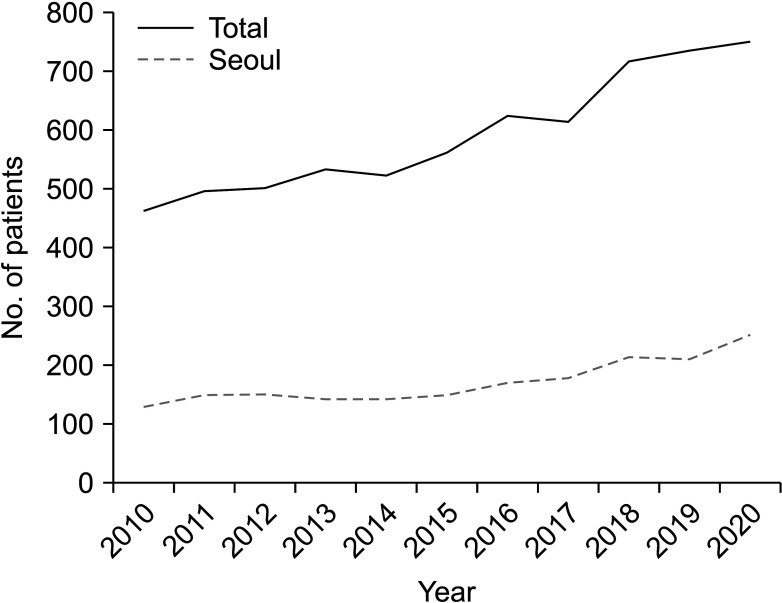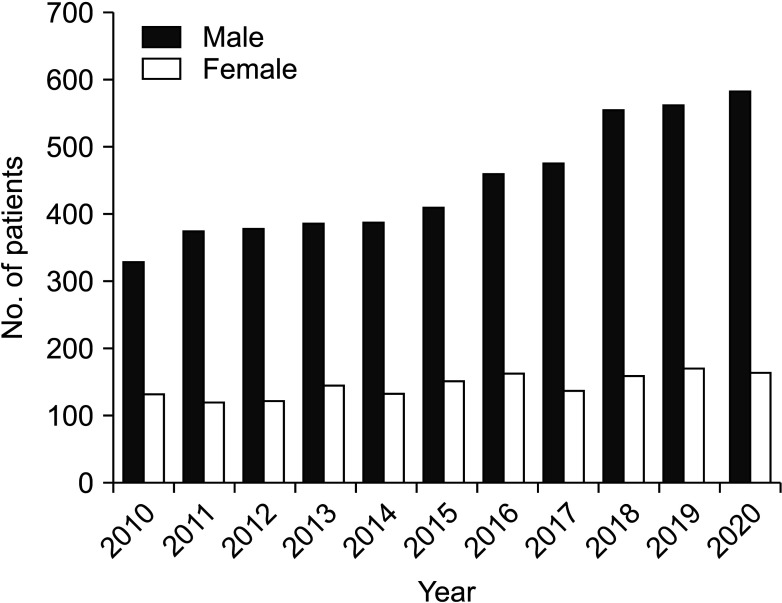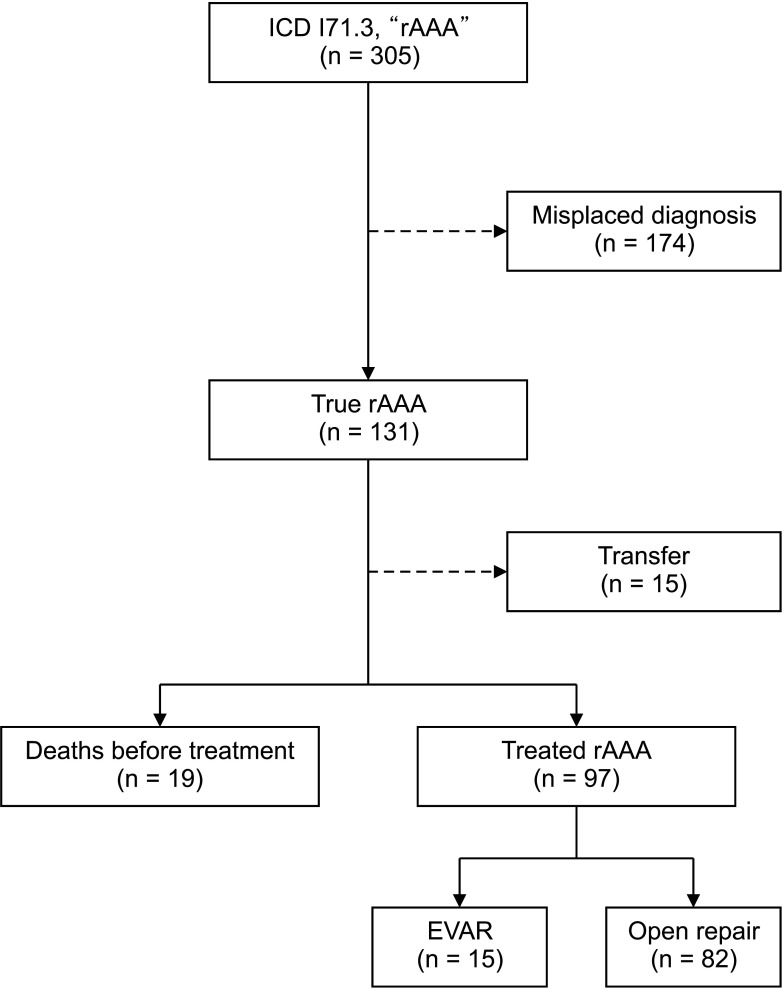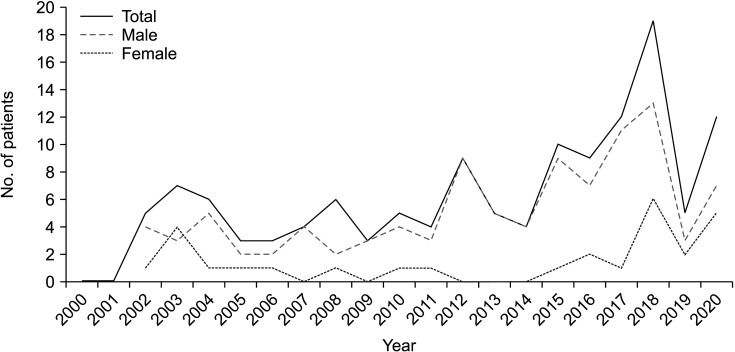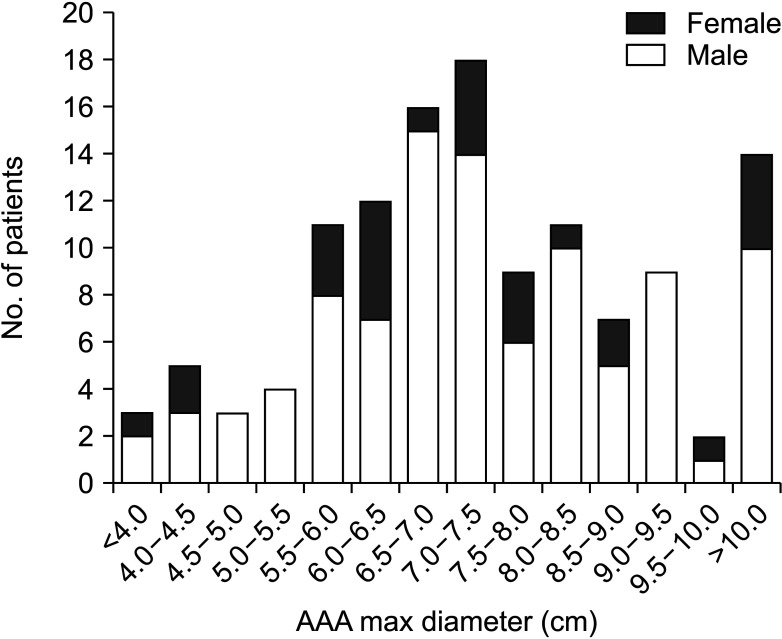Ann Surg Treat Res.
2023 Mar;104(3):170-175. 10.4174/astr.2023.104.3.170.
Validation of I71.3 code for ruptured abdominal aortic aneurysm in Korea: misplaced diagnosis in claims data
- Affiliations
-
- 1Department of Surgery, Seoul National University College of Medicine, Seoul, Korea
- 2Department of Surgery, Seoul Metropolitan Government-Seoul National University Boramae Medical Center, Seoul, Korea
- 3Department of Surgery, Korea University Guro Hospital, Seoul, Korea
- 4Department of Surgery, Kyung Hee University Medical Center, Seoul, Korea
- KMID: 2539696
- DOI: http://doi.org/10.4174/astr.2023.104.3.170
Abstract
- Purpose
Studies in western countries have shown a decline in the incidence of ruptured abdominal aortic aneurysm (rAAA) with advancements in endovascular repair and screening. However, according to health insurance data in Korea based on rAAA code (I71.3), overall rAAA has been increasing. This study aimed to validate the I71.3 code for rAAA and attempt to define the true incidence of rAAA in Korea.
Methods
A 20-year multicenter retrospective review of rAAA was undertaken from the period of January 1, 2000 to December 31, 2020. All patients were diagnosed with the rAAA code I71.3 in each of the 4 hospitals. The CT images and surgical records of these patients were reviewed to differentiate true rAAA and misdiagnosis. Further data on true rAAA patient outcomes including mortality and treatment success were also collected.
Results
A total of 305 rAAA (I71.3) codes were identified in the 4 centers. However, medical record review showed true rAAA in only 131 (43.0%). The remaining 174 cases (57.0%) were misdiagnosed. Impending ruptures were the most common misdiagnoses (37.9%). The total in-hospital mortality including deaths before treatment was 38.9% (n = 51), while mortality of treated patients was 24.4% (n = 15).
Conclusion
The analysis of I71.3 code for rAAA showed that only 43.0% were true rAAA and the remaining 57.0% were misdiagnosed. This indicates that the I71.3 code is overestimated in National Health Insurance-based data and that the true incidence of rAAA could be much lower.
Keyword
Figure
Reference
-
1. IMPROVE Trial Investigators. Comparative clinical effectiveness and cost effectiveness of endovascular strategy v open repair for ruptured abdominal aortic aneurysm: three year results of the IMPROVE randomised trial. BMJ. 2017; 359:j4859. PMID: 29138135.2. Sampson UK, Norman PE, Fowkes FG, Aboyans V, Song Y, Harrell FE Jr, et al. Global and regional burden of aortic dissection and aneurysms: mortality trends in 21 world regions, 1990 to 2010. Glob Heart. 2014; 9:171–180. PMID: 25432126.3. Mota L, Marcaccio CL, Dansey KD, de Guerre LE, O’Donnell TFX, Soden PA, et al. Overview of screening eligibility in patients undergoing ruptured AAA repair from 2003 to 2019 in the Vascular Quality Initiative. J Vasc Surg. 2022; 75:884–892. PMID: 34695553.4. Kontopodis N, Galanakis N, Akoumianakis E, Ioannou CV, Tsetis D, Antoniou GA. Editor’s choice: systematic review and meta-analysis of the impact of institutional and surgeon procedure volume on outcomes after ruptured abdominal aortic aneurysm repair. Eur J Vasc Endovasc Surg. 2021; 62:388–398. PMID: 34384687.5. Budtz-Lilly J, Björck M, Venermo M, Debus S, Behrendt CA, Altreuther M, et al. Editor’s choice: the impact of centralisation and endovascular aneurysm repair on treatment of ruptured abdominal aortic aneurysms based on international registries. Eur J Vasc Endovasc Surg. 2018; 56:181–188. PMID: 29482972.6. Anjum A, von Allmen R, Greenhalgh R, Powell JT. Explaining the decrease in mortality from abdominal aortic aneurysm rupture. Br J Surg. 2012; 99:637–645. PMID: 22473277.7. Wu CY, Chan CY, Huang SC, Chi NS, Wang SS, Wu IH. Outcomes following endovascular or open repair for ruptured abdominal aortic aneurysm in a Chinese population. Heart Vessels. 2014; 29:71–77. PMID: 23306827.8. Tam G, Chan YC, Chong KC, Lee KP, Cheung GC, Cheng SW. Epidemiology of abdominal aortic aneurysms in a Chinese population during introduction of endovascular repair, 1994 to 2013: a retrospective observational study. Medicine (Baltimore). 2018; 97:e9740. PMID: 29489676.9. Choi C, Ahn S, Min SI, Ahn M, Ha J, Yoon HJ, et al. Nationwide epidemiologic study of abdominal aortic aneurysms in Korea: a cross-sectional study using National Health Insurance Review and Assessment Service Data. Vasc Specialist Int. 2019; 35:193–201. PMID: 31915663.10. Kuehnl A, Salvermoser M, Erk A, Trenner M, Schmid V, Eckstein HH. Spatial analysis of hospital incidence and in hospital mortality of abdominal aortic aneurysms in Germany: secondary data analysis of nationwide hospital episode (DRG) data. Eur J Vasc Endovasc Surg. 2018; 55:852–859. PMID: 29685677.11. Starnes BW, Mehta M, Veith FJ. Ruptured abdominal aortic aneurysm. Springer;2016.12. van Walraven C, Wong J, Morant K, Jennings A, Jetty P, Forster AJ. Incidence, follow-up, and outcomes of incidental abdominal aortic aneurysms. J Vasc Surg. 2010; 52:282–289. PMID: 20541348.13. Ladich E, Yahagi K, Romero ME, Virmani R. Vascular diseases: aortitis, aortic aneurysms, and vascular calcification. Cardiovasc Pathol. 2016; 25:432–441. PMID: 27526100.14. Hellmann DB, Grand DJ, Freischlag JA. Inf lammatory abdominal aortic aneurysm. JAMA. 2007; 297:395–400. PMID: 17244836.15. Golledge J. Abdominal aortic aneurysm: update on pathogenesis and medical treatments. Nat Rev Cardiol. 2019; 16:225–242. PMID: 30443031.16. Durieux R, Lardinois MJ, Albert A, Defraigne JO, Sakalihasan N. Outcomes and predictors of mortality in a belgian population of patients admitted with ruptured abdominal aortic aneurysm and treated by open repair in the contemporary era. Ann Vasc Surg. 2022; 78:197–208. PMID: 34416280.17. Meuli L, Menges AL, Steigmiller K, Kuehnl A, Reutersberg B, Held U, et al. Hospital incidence and mortality of patients treated for AAA in Switzerland. Br J Surg. 2022; 109(Supplement_3):znac189–znac001.18. Kim JA, Yoon S, Kim LY, Kim DS. Towards actualizing the value potential of Korea Health Insurance Review and Assessment (HIRA) data as a resource for health research: strengths, limitations, applications, and strategies for optimal use of HIRA data. J Korean Med Sci. 2017; 32:718–728. PMID: 28378543.19. Powell JT, Wanhainen A. Analysis of the differences between the ESVS 2019 and NICE 2020 guidelines for abdominal aortic aneurysm. Eur J Vasc Endovasc Surg. 2020; 60:7–15. PMID: 32439141.

